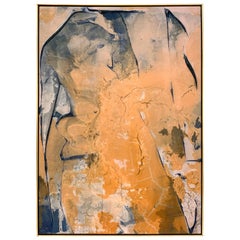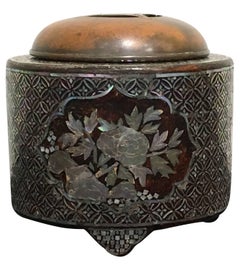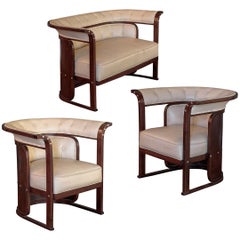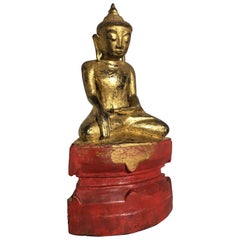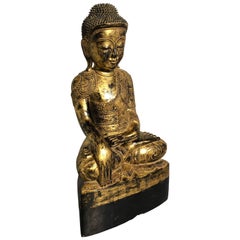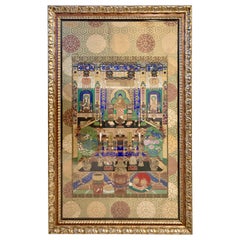Lotus Gallery Furniture
to
2
446
441
4
1
3
3
2
1
1
1
1
147
115
179
5
102
56
17
47
9
11
12
3
2
11
7
3
2
193
143
119
96
78
404
317
183
107
65
446
446
446
2
1
1
1
1
Walter Darby Bannard "Soft Companion", 1977, Acrylic on Canvas
Located in Austin, TX
A wonderful abstract painting by Walter Darby Bannard (1934-2016), entitled "Soft Companion", dated 1977, acrylic on canvas, in a wood and brass frame.
A wonderful abstract or lyr...
Category
Vintage 1970s American Expressionist Paintings
Materials
Canvas, Acrylic
Japanese Edo Period Lacquer and Mother-of-Pearl Embellished Stoneware Koro
Located in Austin, TX
A highly unusual Japanese crackle glazed koro (incense burner or censer), lacquered and inlaid with mother-of-pearl embellishment, signed Gyokusen, Ed...
Category
Antique 19th Century Japanese Edo Scholar's Objects
Materials
Copper
Josef Hoffmann 'Buenos Aires' Suite by J&J Kohn, Austria, Early 20th Century
By Jacob & Josef Kohn, Josef Hoffmann
Located in Austin, TX
A wonderful Vienna Secessionist parlor suite by Josef Hoffman, manufactured before 1920 by J & J Kohn, Vienna, Austria. The suite comprised of a settee and pair of armchairs or club ...
Category
Early 20th Century Austrian Vienna Secession Club Chairs
Materials
Leather, Beech
Shan Burmese Lacquered and Gilt Wood Buddha, Ava Period, 18th Century
Located in Austin, TX
A rare and exquisite 18th century Ava period Shan Burmese figure of the Buddha.
Carved from a single block of wood, lacquered and gilt, the immensely s...
Category
Antique Mid-18th Century Burmese Sculptures and Carvings
Materials
Teak
Burmese Ava Period Carved, Lacquered and Giltwood Buddha, Late 18th Century
Located in Austin, TX
A sublime and rare late 18th century Burmese Ava period carved, lacquered and gilt Buddha. The historical Buddha, Shakyamuni, is portrayed in bhumisparsha mudra, the gesture of calling the Earth to witness, commemorating the moment the Buddha reached enlightenment.
The Buddha is dressed in patchwork...
Category
Antique Late 18th Century Burmese Sculptures and Carvings
Materials
Wood
Large Framed Japanese Buddhist Amida Temple Hall Painting, Mid-19th Century
Located in Austin, TX
A large and incredible Japanese painting of a Buddhist temple hall with Amida Nyorai, late Edo or early Meiji period, mid-19th century, Japan. Mounted wit...
Category
Antique Mid-19th Century Japanese Meiji Paintings and Screens
Materials
Brocade, Silk, Acrylic, Wood, Paint
Japanese Edo Period Igarashi School Long Lacquer Box, Tanzaku-Bako
Located in Austin, TX
A stunning Japanese Edo period lacquer tanzakubako, box for poem cards, late 18th-early 19th century, Edo Period, Japan.
Attributed to the Igarashi School, this box is masterfully ...
Category
Antique Early 19th Century Japanese Edo Lacquer
Materials
Mother-of-Pearl, Lacquer
Large Chinese Export Punchbowl with Staple Repairs, 18th Century
Located in Austin, TX
A remarkable large Chinese export blue and white punchbowl painted with a floral and brocade design, and featuring a stunning staple repair, 18th century...
Category
Antique Late 18th Century Chinese Chinese Export Decorative Bowls
Materials
Iron
Chinese Qing Dynasty Carved Bamboo HeHe ErXian Group, 19th Century
Located in Austin, TX
A wonderful Chinese bamboo figural carving featuring the Taoist immortal twins of eternal youth, known as the HeHe ErXian, Qing dynasty, 19th century.
F...
Category
Antique 19th Century Chinese Qing Sculptures and Carvings
Materials
Bamboo
Pair of Japanese Bronze Hibachi with Silver and Copper Inlay, Meiji Period
Located in Austin, TX
An exquisite pair of Japanese mixed metal bronze hibachi with idyllic landscape scenes, Meiji period (1868-1912), late 19th or early 20th century, Japan.
The hibachi of generous proportions, with a high, slightly splayed foot, a short, narrow waist, and a large and wide cylindrical body. The body decorated in the mixed metal technique. The bronze carved and set with inlays of copper and silver to create wonderful landscape scenes. A pair of animal mask handles to the sides. Each hibachi with a cast signature reading ?? (Toyomi?) to the underside.
One side of each hibachi depicting an evening scene, with scholars walking about a mountain retreat, replete with a waterfall, pavilions, pagodas, and pine trees, all shimmering under a full moon.
The other side of the hibachi depicting a daytime scene, with a view of similar pavilions, pagoda, and pine, though with boats also visible in the distance.
Copper inlay has been used for the roofs and the trunks of the pine trees. Silver inlay has been used for the pine needles, scholars, building supports, water, boats, moon, as well as the distant mountains.
Originally used as a simple and elegant space heater...
Category
Antique Late 19th Century Japanese Meiji Metalwork
Materials
Silver, Bronze, Copper
Life-Sized Shan Burmese Gilt Lacquer Papier Mâché Buddha, circa 1900
Located in Austin, TX
A large and impressive Burmese papier mâché gilt lacquer figure of the historical Buddha, Shakyamuni, Shan States, Burma (now Myanmar) circa 1880 - 1900.
The Buddha sits in vajrasana...
Category
Antique Early 1900s Burmese Sculptures and Carvings
Materials
Lacquer
$12,500 Sale Price
28% Off
Large Burmese Bronze Medicine Buddha, Pagan Style, Late 19th Century
Located in Austin, TX
A large and magnificent cast bronze image of the Medicine Buddha, Bhaisajyaguru, rendered in the Burmese Pagan style, and most likely based on a period example that was either damaged or lost, 19th century, Burma or Thailand.
He can be identified as the Medicine Buddha by the hand that rests in his lap, with his middle finger touching the thumb. A medicine pot or fruit stem would originally have been placed in his upturned palm.
The face of this Buddha has been sculpted masterfully. He has a beautiful heart shaped face topped by hair neatly arranged in the typical "snail shell curls", and surmounted by a high ushnisha. Long, pendulous earlobes frame his face, a symbol of his princely past. He gazes serenely outwards from heavily lidded, downcast eyes, a content smile upon his full, lush lips.
The Buddha is portrayed seated in vajrasana (full lotus position), his elegant hands displayed in varada mudra, the gesture of granting favors and fulfilling wishes. Long, exquisite fingers extended, the thumb and middle finger touching in a gesture of compassion.
He is clothed in a simple kasaya wrapped around his body and over one shoulder, leaving the shoulder and part of his chest bare. The diaphanous garment clings to his body, outlining his well proportioned and graceful, almost sensuous, form. The excess material pooled in neat pleats in front of him. A sash thrown over his shoulder.
He sits upon a double lotus base upon a raised platform. The platform features two kneeling attendants, usually interpreted as the monks Ananda and Kasyapa. Between them is a circular disc representing the Wheel of Dharma. Contained in the disk is a flower with eight petals, symbolizing the eightfold path, one of the principle teachings of the Buddha.
The sides and back of the platform featuring a series of singha, or lions, representative of the Buddha's royal past.
An applied lacquer patina covers the entirety of the image. Large deposits of ash (from incense) are present between the curls of the hair, as well as some the other crevices, indicating this image was the subject of worship for many years.
Bhaisajyaguru, also called the Medicine Buddha, or Buddha of Healing, is a revered figure in the Buddhist pantheon as a master able to cure suffering, both physical and spiritual, through his teachings.
The Pagan Empire ruled most of present day Burma (Myanmar) from 849 to 1297. The capital, Bagan, served as a both the center of government and religion, where Buddhism reigned supreme. Bagan was also at a crossroads of the Buddhist world, with influence from India, Nepal, Tibet, China, and even Indonesia shaping their culture. As such, Pagan Buddha...
Category
Antique Late 19th Century Burmese Sculptures and Carvings
Materials
Bronze
Ming Dynasty Bronze Figure of the Infant Buddha
Located in Austin, TX
A rare and unusual Chinese Ming Dynasty bronze figure of the Buddha as an infant. The young Prince Siddhartha, who would grow up to become the Buddha, is portrayed standing, one hand pointing to the sky, the other to the ground. He is naked, save for a baby apron...
Category
Antique 16th Century Chinese Ming Sculptures and Carvings
Materials
Bronze
Chinese Tang Dynasty Pottery Court Lady
Located in Austin, TX
Painted pottery figure of an opulent Chinese court woman with up-swept hair and standing in a simply draped robe from the Tang Dynasty (618-907 AD). Her beauty is illuminated by the ...
Category
Antique 15th Century and Earlier Chinese Tang Antiquities
Materials
Pottery, Acrylic
Chinoiserie Brown Lacquer and Gilt Decorated Coffee Table
Located in Austin, TX
An attractive French chinoiserie brown lacquer coffee or cocktail table with gilt painted decoration, circa 1940's, France.
Set upon graceful cabriole legs and draped apron, the to...
Category
Vintage 1940s French Chinoiserie Coffee and Cocktail Tables
Materials
Wood, Lacquer
Late 19th Century Italian Baroque Revival Gilt and Polychrome Table Top Vitrine
Located in Austin, TX
An elegant late 19th century Baroque style tabletop vitrine. The vitrine marvelously carved and richly gilt in the Baroque manner, with beautiful foliate scrollwork and polychrome de...
Category
Antique Late 19th Century Italian Baroque Revival Vitrines
Materials
Glass, Giltwood, Velvet
Chinese Turquoise Blue Peking Glass Vase, Republic Period, Early 20th Century
Located in Austin, TX
A small and charming turquoise blue carved Peking glass vase, Republic Period, early 20th century, China.
The Peking glass vase of elegant bottle shape featuring two shades of overlay blue. The outer layer of glass slightly darker than the inner layer. The outer layer of glass carved with a design of flowering branches, including plum blossoms and possibly peony.
The underside with an etched China mark.
Category
Vintage 1920s Chinese Qing Vases
Materials
Glass
Pair Chinese Dragon Fish Glazed Porcelain Vase, Qing Dynasty, 19th-20th Century
Located in Austin, TX
A fantastic pair of Chinese molded and glazed biscuit porcelain vases with leaping dragon fish or makara, late Qing dynasty, circa 1900.
The vases of balu...
Category
Antique Early 1900s Chinese Qing Ceramics
Materials
Porcelain
Japanese Tokyo School Bronze Okimono of a Farmer, Meiji Period
Located in Austin, TX
A very fine and detailed Tokyo School cast bronze okimono (decorative sculpture) of a smiling farmer, Meiji period, late 19th century, Japan.
The e...
Category
Antique Late 19th Century Japanese Meiji Sculptures and Carvings
Materials
Bronze
Small Thai Chiang Saen Bronze Head of the Buddha, 16th Century
Located in Austin, TX
A small and charming fragmentary cast bronze Buddha head with traces of gilding and lacquer, Lan Na Kingdom, Chiang Saen style, 16th century, Thailand.
...
Category
Antique 16th Century Thai Sculptures and Carvings
Materials
Bronze
Chinese Ochre Brown Glazed Martaban Jar, Ming Dynasty, 15th-16th Century
Located in Austin, TX
A fine and large Chinese brown ochre glazed stoneware storage jar, commonly known as a Martaban or Martavan jar, Ming dynasty, 15th-16th century.
The elegant ovoid jar with a slen...
Category
Antique 16th Century Chinese Ming Ceramics
Materials
Stoneware
Chinese Ming Dynasty Glazed Tall Attendant Figure, 16th-17th Century, China
Located in Austin, TX
A tall Chinese green and amber glazed figure of an attendant, Ming Dynasty, 16th-17th century, China.
The figure stands upon an integral plinth, dressed in long robes...
Category
Antique 17th Century Chinese Ming Sculptures and Carvings
Materials
Pottery
Burmese Arakan Lacquered and Gilt Bronze Healing Buddha, 18th Century
Located in Austin, TX
An unusual 18th century Burmese Arakan style red lacquered and richly gilt cast bronze figure of the Crowned Medicine Buddha, commonly referred to as Bhaishajyaguru.
The Supreme Healer is portrayed seated in vajrasana (full lotus position) upon a throne of nine elephants, symbolizing the practice of samatha, or calming the mind (mindfulness) - specifically the nine stages of calm abiding. The hand in his lap holds a jar of healing salve. His other hand rests gently on his knee in varada mudra, the gesture of wish fulfilling, offering a myrobalan seed, a fruit said to be capable of healing emotional ills.
The Healing Buddha...
Category
Antique Mid-18th Century Burmese Sculptures and Carvings
Materials
Bronze
Art Nouveau WMF Silver Plate Tea and Coffee Service Designed by Albert Mayer
By Albert Mayer, WMF Württembergische Metallwarenfabrik
Located in Austin, TX
A whimsically refined Jugendstil German silver plate coffee and tea service with tray, designed by Albert Mayer for WMF and retailed by Casa Costa, A...
Category
Antique Early 1900s German Jugendstil Serving Pieces
Materials
Silver Plate
Massive Japanese Meiji Period Bronze Vase, Late 19th Century, Japan
Located in Austin, TX
A very large Meiji period bronze vase, possibly for temple use, with high relief design and elephant head handles, late 19th century, Japan.
Of baluster form and unusual size, yet ...
Category
Antique Late 19th Century Japanese Meiji Vases
Materials
Bronze
Chinese Early Qing Dynasty Walnut Folding Table, 17th-18th Century, China
Located in Austin, TX
A very fine and rare Chinese Qing Dynasty walnut wood (hetao mu) kang table with folding legs, 17th to 18th century, China.
Crafted in walnut wood (hetao mu), this ingenious table...
Category
Antique Early 18th Century Chinese Qing Furniture
Materials
Walnut
Chinese Export Famille Rose Pheasant With Ormolu Mounts, Late 19th Century
Located in Austin, TX
A gorgeous Chinese export famille rose enameled porcelain model of a pheasant mounted on an ormolu stand.
The elegant bird is portrayed perched on a ...
Category
Antique Late 19th Century Chinese Chinese Export Animal Sculptures
Materials
Ormolu
Pair of Korean Goryeo Dynasty Bronze Pedestal Bowls, 13th-15th Century, Korea
Located in Austin, TX
An exquisite pair of Korean bronze pedestal offering bowls, Goryeo Dynasty, 13th-15th century, Korea.
The Goryeo bronze bowls of generous proportions, with high sides and an ever so slightly everted rim. The bowls are supported on a pedestal base with a tall stem and wide, splayed ring foot.
The bowls plain, save for a single engraved line circumscribing the splayed foot.
The bowls with an amazingly rich and complex patina of mottled reddish browns from cuprite and dark greens from malachite. The bronze heavily cleaned to the European taste, removing most of the encrustations. Some areas of the bowls with rougher areas where the accretions could not be removed.
Crafted in two parts in the spun bronze technique, then joined. The bowls are unusually thin for bronze, with the lathe lines still visible to the undersides.
An unusual form and size for Goryeo period bronze utensils...
Category
Antique 15th Century and Earlier Korean Metalwork
Materials
Bronze
Chinese Export Silver Dragon Spoon by Wang Hing & Co., Late 19th Century
By Wang Hing & Co.
Located in Austin, TX
A very fine and charming Chinese export silver spoon in the form of a dragon, by Wang Hing & Co., Qing Dynasty, late 19th century, China.
...
Category
Antique 1890s Chinese Chinese Export Metalwork
Materials
Silver
Nepalese Gilt Bronze Bodhisattva 'Amoghapasha?', Early to Mid-20th Century
Located in Austin, TX
A beautiful and unusual gilt bronze figure of a Bodhisattva, possibly Amoghapasha, Nepal, early to mid-20th century, circa 1930s or 1940s.
The regal figure possibly depicting the bodhisattva Amoghapasha, the Unfailing Lasso. The enlightened being is portrayed seated upon a high double lotus pedestal. He is dressed as an Indian prince, wearing a luxurious foliate patterned dhoti around his waist and a billowing scarf around his shoulders. . His torso bare save for the jeweled necklaces and the sacred thread. A five pointed crown with an image of Amitabha Buddha in the central point graces his head.
His princely face cold painted with beautiful detail, his hair colored blue with crushed lapis lazuli, indicating his peaceful nature. Amoghapasha holds a lasso in one hand, an axe in the other. He is considered an emanation of Avalokiteshvara. A bodhisattva of compassion, Amoghapasha is so named because of the lasso he holds in his hand. The lasso represents his vast compassion which is thought to extend to encompass all beings, bringing them into a state of perfection and enlightenment.
The copper base plate, seemingly a later replacement, has been inscribed with a visvajra (double vajra...
Category
Mid-20th Century Nepalese Tibetan Sculptures and Carvings
Materials
Lapis Lazuli, Bronze
Large Antique Chinese Hand Painted Wallpaper Section in Carved Hardwood Frame
Located in Austin, TX
A wonderfully charming large and colorful Chinese hand painted wallpaper section in a carved and shaped hardwood frame. The wallpaper dates to the first half of the 20th century or e...
Category
Early 20th Century Chinese Chinese Export Paintings and Screens
Materials
Hardwood, Paper
Nepalese Gilt Bronze Figure of Bodhisattva Chenrezig, Mid-20th Century
Located in Austin, TX
A nice vintage early to mid-20th century gilt bronze sculpture of the Buddhist deity Avalokiteshvara in his four armed form, known as Chaturbuhja, or Chenrezig in Tibet.
Chenrezig, a form of Avalokiteshvara, the bodhisattva of compassion (known as Guan Yin or Kwan Yin in Chinese), sits in vajrasana upon a high double lotus pedestal. One pair of hands is clasped in prayer at heart level, the other pair of hands raised upwards at shoulder lever and holding discreet attributes, a mala (prayer beads) in one hand, a lotus blossom in the other.
Chenrezig is dressed in an elaborately patterned floral dhoti that covers his lower half. His torso bare, shoulders covered with a shawl and scarves that billow out around him. He is festooned with jewels, necklaces, bracelets, armlets, earrings, belt and a five pointed crown. The earrings studded with coral. The crown studded with turquoise. His face is cold painted with beautiful details. The hair has been pigmented blue with crushed lapis, indicating his peaceful nature.
The copper base plate is inscribed with a visvajra (double vajra...
Category
Late 20th Century Nepalese Tibetan Sculptures and Carvings
Materials
Coral, Lapis Lazuli, Bronze
Small Japanese Lacquer Duck Incense Box, Kogo, Meiji Period, Late 19th Century
Located in Austin, TX
An exquisite Japanese Meiji Period small lacquer incense box, kogo, in the form of a duck or goose, late 19th century, Japan.
The delicate lacquer box, known as a kogo in Japanese, ...
Category
Antique Late 19th Century Japanese Meiji Lacquer
Materials
Lacquer
Japanese Mixed Metal Okimono of Doves by Seifu, Meiji Period, Late 19th Century
Located in Austin, TX
A wonderfully naturalistic large Japanese Meiji period mixed metal okimono (ornamental sculpture) of a pair of oriental turtle doves ...
Category
Antique Late 19th Century Japanese Meiji Metalwork
Materials
Bronze, Silver, Copper
Large Early 20th Century Chinese Carved Jade Vase
Located in Austin, TX
A large and impressive Chinese caved jade vase, Republic Period, circa 1930.
Carved from one massive piece of jade. The vase carved with the He He Er Xian...
Category
Early 20th Century Chinese Qing Sculptures and Carvings
Materials
Jade
Chinese Turquoise Dayazhai Style Double Lozenge Jardiniere, Mid-20th Century
Located in Austin, TX
A finely painted Chinese Dayazhai style turquoise glazed double lozenge shaped porcelain jardiniere and underplate with grisaille and gilt decoration,...
Category
Mid-20th Century Asian Qing Ceramics
Materials
Porcelain
Japanese Lacquer Smoking Box, Tabako Bon, Edo Period, 19th Century
Located in Austin, TX
A very fine Japanese maki-e lacquer decorated tabako bon, or smoking box, late Edo Period, mid-19th century, Japan.
The elegant smoking box of black lacquer decorated with a wonderful gold lacquer takamaki-e design of a gnarled and elegantly twisted plum tree with branches in full bloom. A border of golden cranes in flight to the top.
The smoking box, called a tabako bon, is comprised of an open section at the top with inset with two cylindrical metal canisters...
Category
Antique Mid-19th Century Japanese Edo Lacquer
Materials
Lacquer
Khmer Carved Sandstone Male Deity, Style of the Baphoun, 11th Century
Located in Austin, TX
A delightful carved sandstone sculpture of an unidentified male deity, Khmer, Angkor Period, style of the Baphuon, 11th century.
The smil...
Category
Antique 15th Century and Earlier Cambodian Sculptures and Carvings
Materials
Sandstone
Nepalese Carved and Painted Buddhist Manuscript Cover, 15th Century
Located in Austin, TX
A fine and unusual wooden book or manuscript cover with a carved exterior and painted interior, 15th century, Nepal.
The exterior of the manuscript cover exuberantly carved with ...
Category
Antique 15th Century and Earlier Nepalese Tibetan Sculptures and Carvings
Materials
Wood
Straits Chinese Carved Hardwood Bamboo Inlay Display Stand, circa 1900
Located in Austin, TX
A remarkable straits Chinese (also known as Peranakan or Nyonya) carved hardwood and bamboo inlaid and embellished table-form stand, originally for dis...
Category
Early 20th Century Indonesian Qing Scholar's Objects
Materials
Lacquer, Bamboo, Hardwood
Chinese Blue Flambe Glazed Hu Vase, Qing Dynasty, 19th Century, China
Located in Austin, TX
An unusual and spectacular Chinese monochrome blue flambé-glazed hu form porcelain vase, Qing Dynasty, 19th century, China.
The hu vase is heavily potted with elegant proportions...
Category
Antique Early 19th Century Chinese Qing Ceramics
Materials
Porcelain
Chinese Carved Hardwood Scholar's Tray, Qing Dynasty, 19th Century, China
Located in Austin, TX
A sophisticated Chinese carved and pierced hardwood scholar's tray, Qing Dynasty, 19th century, China.
The tray of rectangular form with high sides and rounded corners. The sides...
Category
Antique 19th Century Chinese Qing Scholar's Objects
Materials
Hardwood
Chinese Painted Stucco Head of a Luohan, Song Dynasty, 11th Century, China
Located in Austin, TX
A remarkable Chinese life sized painted stucco head of a luohan, Song, Liao or Jin Dynasty, circa 11th century, China.
The amazingly life-like figure depicts a luohan (sometime spelled lohan), also known as an arhat, one of the original disciples of the Buddha. The elderly man has been molded in stucco with inset glass eyes and painted with idealized, if slightly exaggerated features.
The unidentified luohan sports a bald, or perhaps shaved, domed head above a bulging forehead, symbolizing his vast wisdom. The wrinkles in his furrowed brow, and creases around his eyes add to his realism. The learned man stares out wisely from deep set, heavily lidded inlaid glass eyes that catch the light.
The luohan has high cheekbones and a prominent jawline. His lips full and pursed as if about to speak. The corners of his mouth turned up ever so slightly in a faint smile, causing his gaunt cheeks to dimple charismatically. A series of dots above the upper lip indicate he may originally have sported a mustache of real hair.
This life sized head with extremely realistic features fits into a very narrow time frame of Chinese Buddhist art. Perhaps the most recognized group of large, finely molded Chinese luohan...
Category
Antique 15th Century and Earlier Chinese Sculptures and Carvings
Materials
Glass, Stucco
Craved Rock Crystal Figure of Venus, 20th Century
Located in Austin, TX
A beautiful carved and polished small rock crystal figure of Venus, probably Italy, carved after the antique, early to mid-20th century.
The nak...
Category
Mid-20th Century Italian Classical Roman Figurative Sculptures
Materials
Rock Crystal
Khmer Bronze Uma, Angkor Wat Style, 12th Century, Cambodia
Located in Austin, TX
A small Khmer bronze figure of the Hindu goddess Uma, Angkor Period, Style of Angkor Wat, circa 12th century, Cambodia.
This small Khmer bronze devotiona...
Category
Antique 15th Century and Earlier Cambodian Sculptures and Carvings
Materials
Bronze
Chinese Qing Dynasty Silver Tea Strainer, Late 19th Century, China
Located in Austin, TX
A wonderful Chinese silver tea strainer, Qing Dynasty, possibly Tong Zhi period (1861 to 1875), late 19th century, China.
The silver tea strainer elegantl...
Category
Antique 1870s Chinese Qing Metalwork
Materials
Silver
Chinese Export Silver Sugar Tongs by Luen Wo, Early 20th Century, China
Located in Austin, TX
A wonderful pair of Chinese export silver small sugar tongs in a bamboo pattern by Luen Wo, late 19th or early 20th century, Shanghai, China.
The small silver tongs wonderfully cr...
Category
Early 20th Century Chinese Chinese Export Metalwork
Materials
Silver
Small Chinese Export Silver Dessert Fork, Marked KH, Early 20th Century, China
Located in Austin, TX
A charming, small Chinese export silver dessert fork marked KH and Bai Xi, early 20th century, China.
The small dessert fork with three tines. The ha...
Category
Early 20th Century Chinese Chinese Export Metalwork
Materials
Silver
Chinese Silver Repoussé Box with Warriors, Early 20th Century, China
Located in Austin, TX
A fine late Qing or early Republic Period Chinese silver repoussé box featuring a scene possibly from the Romance of the Three Kingdoms, ...
Category
Early 20th Century Chinese Qing Metalwork
Materials
Silver
Japanese Imari Bowl Centerpiece with French Ormolu Mounts, circa 1900
Located in Austin, TX
An elegant French Louis XVI style Japonisme centerpiece comprised of a large 19th century Meiji Period Japanese Imari Porcelain bowl with French gilt metal ormolu mounts, late 19th-e...
Category
Antique Late 19th Century French Japonisme Centerpieces
Materials
Ormolu
Japanese Orange Red Negoro Lacquer Low Table, Taisho Period, 1920s, Japan
Located in Austin, TX
A striking orange-red lacquer Japanese low tea or coffee table decorated in the negoro lacquer technique, Taisho period, 1920s, Japan.
Of simplistic design, the table has a wonder...
Category
Vintage 1920s Japanese Taisho Coffee and Cocktail Tables
Materials
Softwood, Lacquer
Lopburi Style Cast Bronze Figure of Uma, 13th-14th Century, Thailand
Located in Austin, TX
A charming and unusual cast bronze figure of the Hindu goddess Uma, Lopburi Style, 13th-14th century, Thailand.
Uma, the Hindu goddess of love and beauty, also known as Parvati, i...
Category
Antique 15th Century and Earlier Thai Sculptures and Carvings
Materials
Bronze
Gandharan Stucco Head of a Bodhisattva, Region of Hadda, 3rd-5th Century
Located in Austin, TX
A striking Gandharan molded stucco head of a male Bodhisattva, tentatively identified as Manjushri, ancient region of Gandhara, probably Hadda or surrounding area, 3rd-5th century.
The Bodhisattva is sculpted of stucco in an idealized manner as a youthful male, with soft and kind features, a benign expression on his face. He wears an elaborate pleated turban wrapped around his head, with two sweeping lobes at the front.
His turban secured on one side by a small image of a roaring lion. The lion may be read as a reference to Manjushri, the Bodhisattva of Wisdom, who is often depicted as riding or subduing a roaring lion, a metaphor for taming the wild thoughts of the mind.
Manjushri gazes outwards in a beatific manner from almond shaped eyes, a gentle smile on his lips. The eyes at different levels when looking at the sculpture head on, indicating the original placement of the head was meant to be viewed at an angle.
Remnants of pigments to the eyes, nose, mouth and ears.
Mounted on a custom black metal stand.
Hadda was an important center of Buddhist learning in the early history of Greco Buddhist Gandhara, and at one time may have housed a bone relic of the historical Buddha, Shakyamuni. The sculpture and architecture of Hadda followed Hellenistic artistic conventions faithfully, leading some scholars to believe the distinct Greco Buddhist style of Gandhara was first developed in Hadda before spreading to the rest of the region.
The kingdom of Gandhara was situated at a crossroads of trade and cultures. Being one of the last remnants of Alexander the Great's Empire, the inhabitants of the Greco-Bactrian Buddhist kingdom preserved Greek culture and heritage for centuries after the decline of the Greek Empire...
Category
Antique 15th Century and Earlier Afghan Hellenistic Sculptures and Carvings
Materials
Stucco
Chinese Qing Dynasty Lacquered Wood Guanyin, 18th Century, Southern China
Located in Austin, TX
A Chinese early Qing Dynasty carved and lacquered wood figure of Guanyin, Southern China, 17th/18th century.
Guanyin, the Bodhisattva of Compassion and Mercy, is portrayed seated in dhyanasana, one hand raised in viktara mudra, the gesture of teaching and discourse.
The great bodhisattva is dressed in heavy, loose robes tied at the chest, with a mantle draped over his shoulders. He looks serenely outwards from heavily lidded eyes. Guanyin's face carved beautifully with somewhat feminine features. A large five pointed crown sits upon his head. The larger leaves of the crown carved with indistinct images of the Buddha.
The statue was originally fully lacquered in the deep red gilt lacquer typical of Southern Chinese Buddhist sculpture...
Category
Antique Early 18th Century Chinese Qing Sculptures and Carvings
Materials
Wood
Chinese Yellow and Russet Jade Mythical Beast, Ming Dynasty or Earlier
Located in Austin, TX
A superb Chinese yellow and russet nephrite jade carving of a mythical beast, Ming Dynasty (1368 to 1644) or earlier, China
The mythical beast is portrayed with feline features, i...
Category
Antique 17th Century Chinese Ming Sculptures and Carvings
Materials
Jade
Chinese Carved Celadon and Russet Jade Mythical Animal, Ming Dynasty or Earlier
Located in Austin, TX
A fine and unusual carving of a mythical animal, possibly a pixiu, of celadon and russet nephrite jade, Ming Dynasty or earlier, China.
The mythical animal masterfully carved as a...
Category
Antique 17th Century Chinese Ming Sculptures and Carvings
Materials
Jade
Korean Celadon Glazed Ritual Ewer, Kundika, Goryeo Dynasty, 13th-14th Century
Located in Austin, TX
An understated and very heavily potted celadon glazed Korean ritual ewer or water sprinkler, kundinka, Goryeo Dynasty, 13th-14th century.
The unusu...
Category
Antique 15th Century and Earlier Korean Ceramics
Materials
Stoneware
Korean Goryeo Celadon Glazed Bottle Vase with Kintsugi Repair, 12th Century
Located in Austin, TX
A sublime Korean celadon glazed cup mouth bottle vase, Goryeo Dynasty, 12th century, Korea.
The elegant bottle vase, originally used to serve wine, features a gorgeous Goryeo celadon...
Category
Antique 15th Century and Earlier Korean Ceramics
Materials
Stoneware
Roman Bronze Hand Mirror with Beautiful Patina, circa 1st Century
Located in Austin, TX
A simple and elegant Roman bronze hand mirror, late Republic Period, circa 1st century, Italy.
The bronze mirror of simple form. The round face with a pierced border design. The openwork handle...
Category
Antique 15th Century and Earlier Italian Classical Roman Antiquities
Materials
Bronze
Japanese Giltwood Medicine Buddha, Yakushi Nyorai, Muromachi Period 16th Century
Located in Austin, TX
A striking Japanese late Muromachi Period (1333-1573) lacquered and giltwood figure of Yakushi Nyorai, the Medicine Buddha, seated upon an elaborate car...
Category
Antique 16th Century Japanese Edo Sculptures and Carvings
Materials
Rock Crystal
